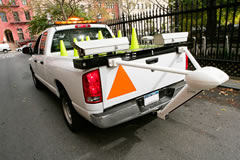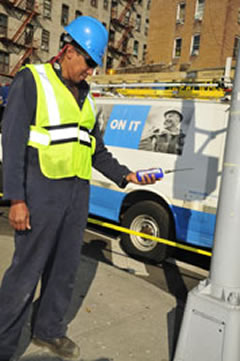Public Safety

Con Edison is committed to integrating public safety considerations in system planning, design work, and system operations. Formal periodic inspection, testing, and maintenance of electric, gas, and steam transmission and distribution infrastructure confirms that system elements will continue to provide safe and reliable service. When field work is performed, extensive requirements for work-area protection are implemented to make certain that Con Edison employees and the public are protected from potential hazards. To help identify and quickly report any hazards that may be associated with street work, a cross-functional team of operating personnel, the Work Area Protection Committee, has been assembled to meet regularly for the purpose of identifying and sharing best practices.
Con Edison of New York also regularly communicates useful safety information to customers in our regular Customer News bill insert. O&R customers receive an insert titled @home. These publications provide seasonal safety tips for severe weather and remind customers about staying safe around downed power lines. In addition, the inserts along with O&R and Con Edison of New York websites offer safety tips about residential electric and gas use, along with information about carbon monoxide and generator safety. In 2012, Con Edison also began to send e-mail communications in preparation for and during severe weather, reminding customers how to report outages and sharing critical safety information related to the storm.
Stray voltage testing
Con Edison of New York performs extensive stray-voltage testing on an ongoing basis. Stray voltage is the term for the presence of electrical energy where it should not be present, such as on lampposts, sidewalk grates, or other structures. The company uses a fleet of vehicle-mounted-mobile stray-voltage detectors to test equipment and ensure public safety. The high-tech vehicles are dispatched throughout the company’s service territory year-round and use sensors to detect stray voltage as low as one volt on manhole covers, gratings, service boxes, light poles, neon signs, and other structures. Stray voltage can also be detected through manual contact voltage testing.
The mobile stray-voltage-detectors enable Con Edison of New York to perform multiple scans of geographic areas more quickly than using manual testing alone. The vehicles have the advantage of not needing to make direct contact with a structure to test it for stray voltage. The manual testing program, involving crews with hand-held voltage detection equipment, surveys structures in New York City and Westchester County once a year. The vehicles, however, are able to conduct system-wide surveys far more frequently. In 2012, the company completed 11 system sweeps using the mobile detectors. In 2012, as a result of stray-voltage surveys, the company found and eliminated 3,056 cases of stray voltage. Of this total, 1,637, approximately 54 percent, were on non-company equipment, such as streetlights, electric signs, and other structures.
Orange and Rockland carries out comparable stray-voltage testing in its territory. During 2012, there were 101,890 overhead and 18,324 underground distribution structures tested. In addition, 6,577 transmission structures and 69 substation fences were stray-voltage tested. 2,522 traffic signals and street lights were also tested. For all of 2012, there were 18 stray-voltage findings in excess of one volt identified in the Orange and Rockland service territory. All were corrected, and there were no associated injuries.
 Con Edison’s extensive stray-voltage testing program checks company-owned equipment, as well as street lights, fences, and other structures.
Con Edison’s extensive stray-voltage testing program checks company-owned equipment, as well as street lights, fences, and other structures.
 Crews use hand-held detection equipment to survey structures for stray voltage.
Crews use hand-held detection equipment to survey structures for stray voltage.
